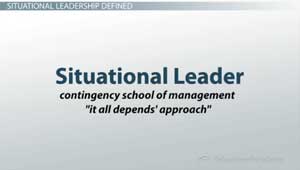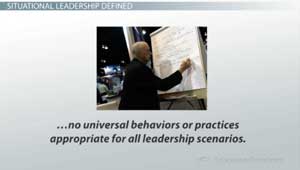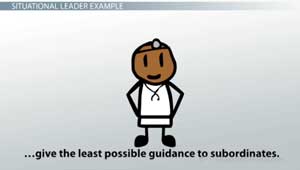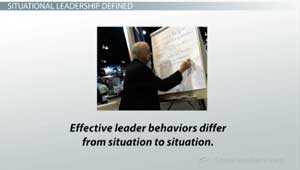The Situational Leader - Answers
The answers are in BOLD below.
NOTE: The transcript from the video is listed below the quiz for your reference.
1. A situational leader must make quick decisions without assessing all factors surrounding the situation.
- TRUE
- FALSE
2. Situational leaders will adjust their style to accommodate any __________ that surround the situation, themselves, and the subordinates.
- proficiencies
- obligations
- limitations
-
opportunities
3. A situational leader must assess what factors before making decisions?
- situation
- capacity of followers
- capacity of leader
- all of these
4. According to situational theory, a set of universal behaviors or practices should be used by managers.
- TRUE
- FALSE
5. Situational management emerged out of what school of thought?
- behaviorist
- contingency
- classical
- contemporary
Discover what makes the situational leader different from other types of leaders, following the contingency school of management. Learn how situational leadership is applied in the workplace.
The Situational Leader
You like pot-a-to. I like pot-ah-to. You like tom-a-to. I like tom-ah-to. Pot-a-to, pot-ah-to, tom-a-to, tom-ah-to - who's to say which is right? Depending on your preference, I am sure you could easily argue one is better than the other, but is that always true in every situation? The situational leader would suggest not.
Situational Leadership Defined
The situational leader emerged out of the contingency school of management, which can be summarized as the 'it all depends' approach.
 |
 |
They believe effective leader behaviors differ from situation to situation. A manager must choose the appropriate management style based on the leadership situation and the capacity of both the leader and his or her followers. Consequently, before the situational leader can make decisions, they have to first assess these factors. The situational leader will then adjust their style to accommodate any limitations that surround the situation, themselves and the subordinates.
Situational Leader Example
To better understand situational leadership, let's take a look at this example.
 |
 |
The situation is high risk, and while Sanjay's subordinates may have the necessary skills to handle the situation on their own, he does not allow room for error. Sanjay knows that he must offer direction based on what he feels is best for the patient. There is no time to discuss, collaborate or vote on decisions. Sanjay must quickly assess the situation for what needs to be done and who the best people are to do it.
Lesson Summary
Let's review. Situational theorists believe universal behaviors or practices do not exist, and effective leaders know how to vary their behaviors from situation to situation.
 |